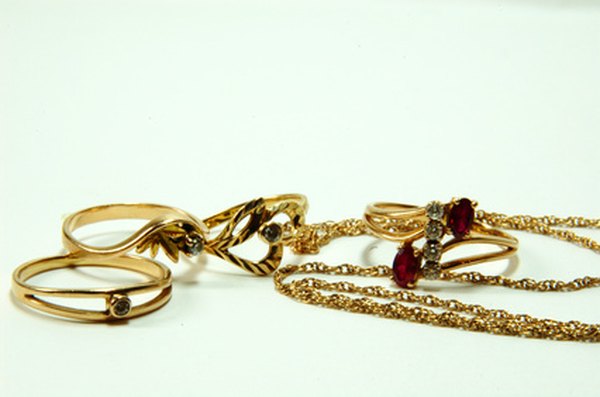What Are the Different Markings Used to Identify Real Gold?
Jewelry markings tell you the percentage of gold in each item.
jewelry image by Aleksey Ubozhenko from Fotolia.com
Federal law requires that gold jewelry sold in the United States must be marked with the gold content. The U.S. jewelry industry has standardized the marking of real gold items through Voluntary Product Standard PS 68-76. The jewelry manufacturer bears the responsibility and legal liability for ensuring the actual gold content is what the marking indicates the gold content should be.
Karat Markings
The gold content of jewelry made of gold alloys is expressed in karats. Pure gold is 24 karats. But U.S. jewelry manufacturers generally don't make their products out of pure gold. They alloy gold with a harder metal such as copper to make the jewelry more resistant to wear. Gold jewelry sold in the U.S. typically is 10, 12, 14, 18 or 22 karat, marked with the number followed by a letter K . The mark -- for instance, “14K” -- typically is stamped on a place that doesn’t show when the jewelry is worn, such as the inside of a gold ring or on the clasp of a gold necklace.
Gold Content
A piece of gold alloy jewelry marked 10K contains 41.67 percent gold, a 12K item is 50 percent gold, a 14K piece contains 58.33 percent gold, an 18K item contains 75 percent gold, and a 22K item contains 91.67 percent gold. A piece of jewelry made of a gold alloy below 10K cannot legally be sold as “gold” jewelry in the U.S. even if marked with the karat gold content. The manufacturer or seller must call the alloy by some name other than gold. For example, Tiffany & Co. in 2012 introduced jewelry made from a low-karat alloy that it trade-named Rubedo. This golden-red alloy contains only 31 percent gold, equivalent to 7.5 karats.
Gold Filled
Jewelry marked as “gold filled” or GF, “gold overlay” or GO, or “rolled gold plate” or RGP, is made of a base metal such as copper or nickel that has had a heavy coat of 10, 12 or 14 karat gold alloy bonded to it through a mechanical hot rolling process. An item can be marked as gold filled if the weight of the karat gold alloy constitutes at least 5 percent of the total metal weight of the item. A typical marking on gold-filled jewelry might read “14K GF” meaning it was made of metal coated with a 14 karat gold alloy, with the alloy making up 5 percent of the item’s total metal weight. An item can be marked as gold overlay or rolled gold plate if the karat gold alloy comprises at least 2.5 percent of the total metal weight. A typical marking could read “14K GO” or “14K RGP.”
Gold Plated
Gold plated jewelry is made of a base metal such as copper that has been thinly coated with 10, 12 or 14 karat gold alloy through a mechanical or electrical plating process. The thickness of the plating is measured in micro-inches. One micro-inch equals 1 millionth of an inch. A jewelry item can be sold as “gold plated” or GP if the gold alloy plating is at least 20 micro-inches thick. Such an item could be marked as “14K GP.” Items with a thinner plating of gold must be marked as either “gold washed” or “gold flashed” or “gold electroplate.” The coating must be at least 7 micro-inches thick in order to use the word “gold” to describe the item. An item can be marked as “heavy” gold plate or electroplate if the alloy gold coating is at least 100 micro-inches thick. Such an item couldbe marked “14K HGP” or “14K HEP.”
References
Writer Bio
Herb Kirchhoff has more than three decades of hands-on experience as an avid garden hobbyist and home handyman. Since retiring from the news business in 2008, Kirchhoff takes care of a 12-acre rural Michigan lakefront property and applies his experience to his vegetable and flower gardens and home repair and renovation projects.

